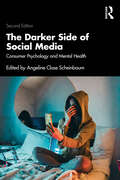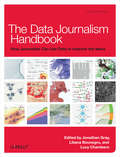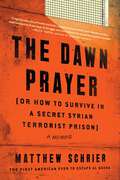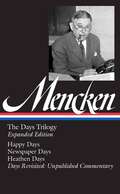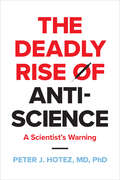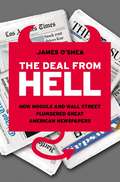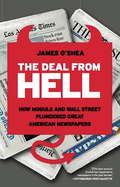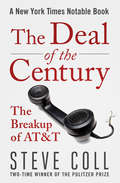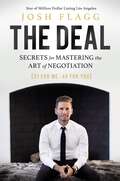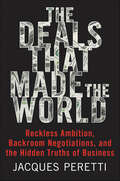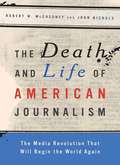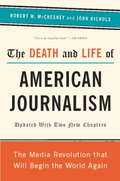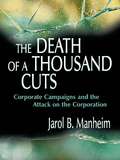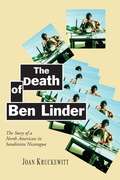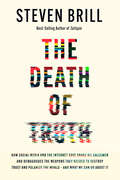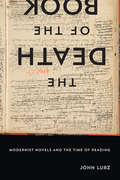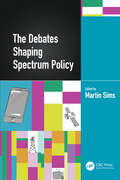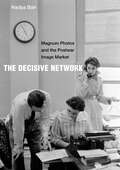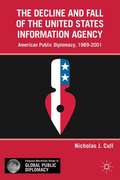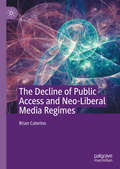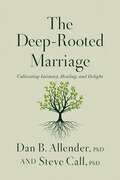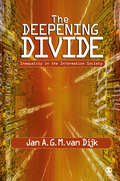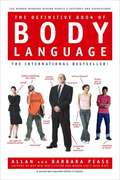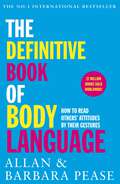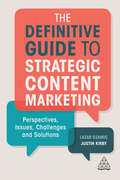- Table View
- List View
The Darker Side of Social Media: Consumer Psychology and Mental Health
by Angeline Close ScheinbaumThe Darker Side of Social Media: Consumer Psychology and Mental Health takes a research-based, scientific approach to examining problematic issues and outcomes that are related to social media use by consumers. Now in its second edition, it relies on psychological theories to help explain or predict problematic online behavior within the social media landscape through the lens of mental health.With an aim to provide solutions, the authors spotlight the key issues affecting consumer well-being and mental health due to the omnipresence and overuse of social media. The book dissects the unintended consequences of too much social media use, specifying key problems like disconnection anxiety, eating disorders, online fraud, cyberbullying, the dark web, addiction, depression, self-discrepancies, and serious privacy concerns (especially impacting children or young people). The book provides grapples with mental health disorders such as anxiety, depression, self-harm, and eating disorders that can be intensified by, or correlated with, too much social media use. The authors meticulously review the various facets of the darker side of online presence and propose actionable solutions for each of the problems stated, providing scholars with a conceptual model with propositions for continued research.This international exploration of social media is a must-read for students of marketing, advertising, and public relations, as well as scholars/managers of business, marketing, psychology, communication, management, and sociology. It will also be of interest to social media users, those navigating new media platforms parents, policymakers, and practitioners.
The Data Journalism Handbook: How Journalists Can Use Data to Improve the News
by Jonathan Gray Lucy Chambers Liliana BounegruWhen you combine the sheer scale and range of digital information now available with a journalist’s "nose for news" and her ability to tell a compelling story, a new world of possibility opens up. With The Data Journalism Handbook, you’ll explore the potential, limits, and applied uses of this new and fascinating field.This valuable handbook has attracted scores of contributors since the European Journalism Centre and the Open Knowledge Foundation launched the project at MozFest 2011. Through a collection of tips and techniques from leading journalists, professors, software developers, and data analysts, you’ll learn how data can be either the source of data journalism or a tool with which the story is told—or both.Examine the use of data journalism at the BBC, the Chicago Tribune, the Guardian, and other news organizationsExplore in-depth case studies on elections, riots, school performance, and corruptionLearn how to find data from the Web, through freedom of information laws, and by "crowd sourcing"Extract information from raw data with tips for working with numbers and statistics and using data visualizationDeliver data through infographics, news apps, open data platforms, and download links
The Dawn Prayer: A Memoir
by Matthew Schrier"What is your name?" asked General Mohammad. "Matthew," I said. I had stopped saying Matt a while ago because it means &‘dead' in Arabic. On New Year's Eve in 2012, Matthew Schrier was headed home from Syria, where he'd been photographing the intense combat of the country's civil war. Just 45 minutes from the safety of the Turkish border, he was taken prisoner by the al Nusra Front—an organization the world would come to know as the Syrian branch of Al Qaeda. Over the next seven months he would endure torture and near starvation in six brutal terrorist prisons. He'd face a daily struggle just to survive. And, eventually, he'd escape. In this gripping, raw, and surprisingly funny memoir, Schrier details the horrifying and frequently surreal experience of being a slight, wisecracking Jewish guy held captive by the world's most violent Islamic extremists. Managing to keep his heritage a secret, Schrier used humor to develop relationships with his captors—and to keep himself sane during the long months of captivity. The Dawn Prayer (Or How to Survive in a Secret Syrian Terrorist Prison): A Memoir is a tale of patriotism and unimaginable bleakness shot through with light . . . of despair and friendship, sacrifice and betrayal, in a setting of bombed-out buildings and shifting alliances. It's the story of the first Westerner to escape al Qaeda—not a battle-hardened soldier, but an ordinary New Yorker who figured out how to set his escape plan in motion from a scene in Jurassic Park. From the prisoners' fiercely competitive hacky sack games and volleyball tournaments (played using a ball made of shredded orange peels and a shoelace) to his own truly nail-biting outbreak, Matthew Schrier's story is unforgettable—and one you won't want to miss.
The Days Trilogy
by H. L. MenckenA major literary event: Mencken’s dazzling autobiography, with 200 pages of his own never-before-published commentary and photos. In 1936, at the age of fifty-five, H. L. Mencken published a reminiscence about his boyhood in The New Yorker, beginning a long and magnificent adventure in autobiography by America’s greatest journalist. Mencken went on to gather his childhood recollections in Happy Days (1940), a richly detailed, poignant account of growing up in Baltimore. A critical and popular success, the book surprised many with its glimpses of a less curmudgeonly Mencken, and there soon followed the absorbing sequels Newspaper Days (1941), charting his rise at the Baltimore Herald from cub reporter to editor, and Heathen Days (1943), recounting his varied excursions as journalist and public figure, including his coverage of the Scopes trial in 1925. But unknown to the legions of Days books’ admirers, Mencken continued to add to them after publication, annotating and expanding each volume in typescripts sealed to the public for twenty-five years after his death. Until now, most of this material—often more frank and unvarnished than the original Days books—has never been published. Containing nearly 200 pages of previously unseen writing, and illustrated with photographs from Mencken’s archives, many taken by Mencken himself, this expanded and definitive edition of the Days trilogy is a cause for celebration.
The Deal from Hell
by James O'SheaIn 2000, after the Tribune Company acquired Times Mirror Corporation, it comprised the most powerful collection of newspapers in the world. How then did Tribune nosedive into bankruptcy and public scandal? <P><P>In The Deal From Hell, veteran Tribune and Los Angeles Times editor James O'Shea takes us behind the scenes of the decisions that led to disaster in boardrooms and newsrooms from coast to coast, based on access to key players, court testimony, and sworn depositions. The Deal From Hell is a riveting narrative that chronicles how news industry executives and editors--convinced they were acting in the best interests of their publications--made a series of flawed decisions that endangered journalistic credibility and drove the newspapers, already confronting a perfect storm of political, technological, economic, and social turmoil, to the brink of extinction.
The Deal from Hell: How Moguls and Wall Street Plundered Great American Newspapers
by James O'SheaIn 2000, after the Tribune Company acquired Times Mirror Corporation, it comprised the most powerful collection of newspapers in the world. How then did Tribune nosedive into bankruptcy and public scandal? In The Deal From Hell, veteran Tribune and Los Angeles Times editor James O'Shea takes us behind the scenes of the decisions that led to disaster in boardrooms and newsrooms from coast to coast, based on access to key players, court testimony, and sworn depositions.The Deal From Hell is a riveting narrative that chronicles how news industry executives and editors--convinced they were acting in the best interests of their publications--made a series of flawed decisions that endangered journalistic credibility and drove the newspapers, already confronting a perfect storm of political, technological, economic, and social turmoil, to the brink of extinction.
The Deal of the Century: The Breakup of AT&T
by Steve CollA New York Times–bestselling author&’s &“superbly reported&” account of the dismantling of the world&’s largest corporation (The Washington Post). Written by the two-time Pulitzer Prize–winning author of Ghost Wars and Private Empire, The Deal of the Century chronicles the decade-long war for control of AT&T. When the US Department of Justice brought an antitrust lawsuit against AT&T in 1974, the telecommunications giant held a monopoly on phone service throughout the country. Over the following decade, an army of lawyers, executives, politicians, and judges spent countless hours clashing over what amounted to the biggest corporate breakup in American history. From boardroom to courtroom, Steve Coll untangles the myriad threads of this complex and critical case and gives readers &“an excellent behind-the-scenes look&” at the human drama involved in the remaking of an entire industry (The Philadelphia Inquirer). Hailed by the New York Times Book Review as &“rich, intricate and convincing,&” The Deal of the Century is the definitive narrative of a momentous turning point in the way America does business.
The Deal: Secrets for Mastering the Art of Negotiation
by Josh FlaggLEARN STRATAGIES FOR SUCCESSFUL DEAL MAKINGStar of the hit show Million Dollar Listing Los Angeles, Josh Flagg shares his secrets to mastering any negotiation in any industry and at any level.Throughout his career, Josh Flagg has faced off with challengers of all kinds in negotiations over the world&’s most expensive and sought-after real estate. He has seen and put into practice what works and identified the &“common tricks&” that don&’t. Josh has curated ten rules that, when applied to any deal, will significantly increase your chance of success, and make you the master negotiator your clients need you to be. Sample rules include:Rule #1: Don&’t Sell Garbage- you are what you sell.Rule #2: You Only Have One Client- focus on the one you&’re with.Rule #3: Up Your Attitude- be the person people want to represent them.Rule #8: Play the Psychologist- you are your client&’s best friend.Rule #10: Know Your Worth- you are your best advocate.If you want to be the best, you have to look and act like the best. Josh learned this rule young and has applied it to every client relationship he has ever had. He began his real estate career as a student at Beverly Hills High School—swung big and hit—landing him in the perfect position to take on some of LA&’s largest, most exclusive real estate listings and, eventually, a spot on Million Dollar Listing Los Angeles. Apply the lessons in the book to become the negotiator who closes million-dollar deals.
The Deals that Made the World: Reckless Ambition, Backroom Negotiations, and the Hidden Truths of Business
by Jacques Peretti"Excellent. ... Impressive." —Financial TimesAn award-winning investigative journalist takes us inside the ten business deals that have transformed the modern worldWe tend to think of our world as controlled by forces we basically understand, primarily the politicians we elect. But in The Deals That Made the World, Jacques Peretti makes a provocative and quite different argument: much of the world around us—from the food we eat to teh products we buy to the medications we take—is shaped by private negotiations and business deals few of us know about.The Deals That Made the World takes us inside the sphere of these powerful players, examining ten groundbreaking business deals that have transformed our modern economy. Peretti reveals how corporate executives engineered an entire diet industry built on failure; how PayPal conquered online payments (and the specific behavioral science that underpins its success); and how pharmaceutical executives concocted a plan to successfully market medications to healthy people.For twenty years, Peretti has interviewed the people behind the decisions that have altered our world, from the CEOs of multinational corporations to politicians, economists, and scientists. Drawing on his vast knowledge, Peretti reveals a host of fascinating and startling connections, from how Wall Street's actions on food commodities helped spark the Arab Spring to the link between the AIDS epidemic in 1980s San Francisco and the subprime mortgage crisis of 2008. Touching upon tech, finance, artificial intelligence, and the other levers of power in a postglobalization environment, Peretti offers a compelling way to understand the last hundred years—and a suggestion of what the next hundred might hold.An essential book for anyone seeking to understand the hidden forces that shape our modern economy, The Deals That Made the World is illuminating and surprising—and an immensely fun read.
The Death and Life of American Journalism
by Robert W. Mcchesney Nichols JohnDaily newspapers are closing across America. Washington bureaus are shuttering; whole areas of the federal government are now operating with no press coverage. International bureaus are going, going, gone. Journalism, the counterbalance to corporate and political power, the lifeblood of American democracy, is not just threatened. It is in meltdown. In The Death and Life of American Journalism, Robert W. McChesney, an academic, and John Nichols, a journalist, who together founded the nation’s leading media reform network, Free Press, investigate the crisis. They propose a bold strategy for saving journalism and saving democracy, one that looks back to how the Founding Fathers ensured free press protection with the First Amendment and provided subsidies to the burgeoning print press of the young nation.
The Death and Life of American Journalism: The Media Revolution That Will Begin the World Again
by John Nichols Robert McchesneyAmerican journalism is collapsing as newspapers and magazines fail and scores of reporters are laid off across the country. Conventional wisdom says the Internet is to blame, but veteran journalists and media critics Robert W. McChesney and John Nichols disagree. The crisis of American journalism predates the Great Recession and digital media boom. What we are witnessing now is the end of the commercial news model and the opportune moment for the creation of a new system of independent journalism, one subsidized by the public and capable of safeguarding our democracy.
The Death of A Thousand Cuts: Corporate Campaigns and the Attack on the Corporation
by Jarol B. ManheimA corporate campaign is an organized assault on the reputation of a company that has offended some interest group. Although corporate campaigns often involve political, economic, and legal tactics, they are centered around the media, where protagonists attempt to redefine the image--and undermine the reputation--of the target company. It is a strategy most frequently employed by unions but is also employed by special interests, such as environmental or human rights groups. Sometimes it is even employed by one corporation against another. It is a rapidly growing phenomenon that is still unknown to the general public, to most academics and journalists, and is rarely understood by the corporations that find themselves on the firing line. The Death of a Thousand Cuts argues and demonstrates that corporate campaigns are a distinctive phenomenon whose manifestations are today ubiquitous in both the marketplace and the media. This volume examines, in considerable detail, the history, strategy, tactics, effects, consequences, and likely future directions of the corporate campaign and of its nonlabor-based cousin, the anticorporate campaign. The book is based on ample sources and methods, among them an extensive review and analysis of media coverage, news releases, previous scholarship, union publications, campaign materials, interviews and conversations with individuals who have experienced corporate campaigns, public presentations by labor leaders and others, correspondence, Internet postings, case law summaries, documents, videotapes, and other materials. Through original data and interpretation, this book adds context and integration to these materials thus giving them new meaning. Key features of this outstanding new book include: * A thorough and clear explanation of what a corporate campaign is and how it differs from other more mundane "public relations" campaigns. * A detailed examination of strategies and tactics that includes their historical development. Some of the more high profile target companies in recent years include Coca-Cola, Microsoft, Caterpillar, Campbell's Soup, Federal Express, General Dynamics, Home Depot, International Paper, K-Mart, Nike, Texaco, Walmart, Starbucks, and UPS. * Hundreds of examples that help explain such contemporary events as the anti-sweatshop movement on college campuses, the living wage movement, and the protests against the World Trade Organization, International Monetary Fund, and World Bank. * A lengthy appendix contains abbreviated descriptions of nearly 200 corporate campaigns waged by labor unions and various advocacy groups since the idea of the corporate campaign was first developed in the 1960's.
The Death of Ben Linder: The Story of a North American in Sandinista Nicaragua
by Joan KruckewittIn 1987, the death of Ben Linder, the first American killed by President Reagan's "freedom fighters" -- the U.S.-backed Nicaraguan Contras -- ignited a firestorm of protest and debate. In this landmark first biography of Linder, investigative journalist Joan Kruckewitt tells his story. In the summer of 1983, a 23-year-old American named Ben Linder arrived in Managua with a unicycle and a newly earned degree in engineering. In 1986, Linder moved from Managua to El Cuá, a village in the Nicaraguan war zone, where he helped form a team to build a hydroplant to bring electricity to the town. He was ambushed and killed by the Contras the following year while surveying a stream for a possible hydroplant. In 1993, Kruckewitt traveled to the Nicaraguan mountains to investigate Linder's death. In July 1995. she finally located and interviewed one of the men who killed Ben Linder, a story that became the basis for a New Yorker feature on Linder's death. Linder's story is a portrait of one idealist who died for his beliefs, as well as a picture of a failed foreign policy, vividly exposing the true dimensions of a war that forever marked the lives of both Nicaraguans and Americans.
The Death of Truth: How Social Media and the Internet Gave Snake Oil Salesmen and Demagogues the Weapons They Needed to Destroy Trust and Polarize the World--And What We Can Do
by Steven BrillHow did we become a world where facts—shared truths—have lost their power to hold us together as a community, as a country, globally? How have we allowed the proliferation of alternative facts, hoaxes, even conspiracy theories, to destroy our trust in institutions, leaders, and legitimate experts? Best-selling journalist Steven Brill documents the forces and people, from Silicon Valley to Madison Avenue to Moscow to Washington, that have created and exploited this world of chaos and division—and offers practical solutions for what we can do about it."A precise description of the punishment cell we have built around our minds and the first few steps back towards light and air." –Timothy Snyder, Author of On Tyranny and Professor of History, Yale University&“A seminal, ground-breaking, documented and honest examination of two of the central dilemmas of our time—what is truth and where to find it.&” —Bob Woodward, associate editor at The Washington PostAs the cofounder of NewsGuard, a company that tracks online misinformation, Steven Brill has observed the rise of fake news from a front-row seat. In The Death of Truth, with startling, often terrifying clarity, he explains how we got here—and how we can get back to a world where truth matters.None of this—conspiracy theories embraced, expertise ridiculed, empirical evidence ignored—has happened by accident. Brill takes us inside the decisions made by executives in Silicon Valley to code the algorithms embedded in their social media platforms to maximize profits by pushing divisive content. He unravels the ingenious creation of automated advertising buying systems that reward that click-baiting content and penalize reliable news publishers, and describes how the use of these ad-financed, misinformation platforms by politicians, hucksters, and conspiracy theorists deceives ordinary citizens. He documents how the most powerful adversaries of America have used American-made social media and advertising tools against us with massive disinformation campaigns—and how, with the development of generative artificial intelligence, everything could get exponentially worse unless we act. The stakes are high for all of us, including Brill himself, whose company's role in exposing Russian disinformation operations resulted in a Russian agent targeting him and his family.Crucially, Brill lays out a series of provocative but realistic prescriptions for what we can do now to reverse course—proposals certain to stir debate and even action that could curb the power of big tech to profit from division and chaos, tamp down polarization, and restore the trust necessary to bring us together.
The Death of the Book: Modernist Novels and the Time of Reading
by John LurzAn examination of the ways major novels by Marcel Proust, James Joyce, and Virginia Woolf draw attention to their embodiment in the object of the book, The Death of the Book considers how bookish format plays a role in some of the twentieth century’s most famous literary experiments. Tracking the passing of time in which reading unfolds, these novels position the book’s so-called death in terms that refer as much to a simple description of its future vis-à-vis other media forms as to the sense of finitude these books share with and transmit to their readers.As he interrogates the affective, physical, and temporal valences of literature’s own traditional format and mode of access, John Lurz shows how these novels stage intersections with the phenomenal world of their readers and develop a conception of literary experience not accounted for by either rigorously historicist or traditionally formalist accounts of the modernist period. Bringing together issues of media and mediation, book history, and modernist aesthetics, The Death of the Book offers a new and deeper understanding of the way we read now.
The Debates Shaping Spectrum Policy
by Martin SimsWhat debates have caused spectrum policy to change course and which will determine its future direction? This book examines these issues through a series of chapters from a range of notable experts. The backdrop is a period of turbulent change in what was once a quiet backwater. The past quarter century has seen wireless connectivity go from nice-to-have luxury to the cornerstone of success as nations battle for leadership of the digital economy. The change has been reflected in the crucial role now played by market's mechanisms in a field once dominated by administrative decisions. Spectrum policy’s goals have moved far beyond the efficient use of the airwaves to include encouraging economic development, investment, innovation, sustainability and digital inclusivity. Are historic procedures still appropriate in the face of this multiplicity of demands? Are market mechanisms like auctions still the best way to deliver what has become essential infrastructure? Does the process of international coordination need to change? Is spectrum policy’s effectiveness limited by the power of global economic forces? Can it reduce rather than add to global warming? Where does 6G and AI fit in? Is public perception the new spectrum policy battle ground? These are all issues examined in The Debates Shaping Spectrum Policy.
The Decisive Network: Magnum Photos and the Postwar Image Market
by Nadya BairSince its founding in 1947, the legendary Magnum Photos agency has been telling its own story about photographers who were witnesses to history and artists on the hunt for decisive moments. Based on unprecedented archival research, The Decisive Network unravels Magnum’s mythologies to offer a new history of what it meant to shoot, edit, and sell news images after World War II. Nadya Bair shows that between the 1940s and 1960s, Magnum expanded the human-interest story to global dimensions while bringing the aesthetic of news pictures into new markets. Working with a vast range of editorial and corporate clients, Magnum made photojournalism integral to postwar visual culture. But its photographers could not have done this alone. By unpacking the collaborative nature of photojournalism, this book shows how picture editors, sales agents, spouses, and publishers helped Magnum photographers succeed in their assignments and achieve fame. Bair concludes in the late 1960s and early 1970s, when changing market conditions led Magnum to consolidate its brand. In that moment, Magnum’s photojournalists became artists and their assignments oeuvres. Bridging art history, media studies, cultural history, and the history of communication, The Decisive Network transforms our understanding of the photographic profession and the global circulation of images in the predigital world.
The Decline and Fall of the United States Information Agency
by Nicholas J. CullUsing newly declassified archives and interviews with practitioners, Nicholas J. Cull has pieced together the story of the final decade in the life of the United States Information Agency, revealing the decisions and actions that brought the United States' apparatus for public diplomacy into disarray.
The Decline of Public Access and Neo-Liberal Media Regimes
by Brian CaterinoThis book examines the reasons behind the declining fortunes of public access channels. Public access, which provided perhaps the boldest experiment in popular media democracy, is in steep decline. While some have argued it is technologically outmoded, Caterino argues that the real reason lies with the rise of a neo-liberal media regime. This regime creates a climate in which we can understand these changes. This book considers the role of neo-liberalism in transforming notions of public obligations and regulation of media that have impacted non-profit media, specifically public access. Neo-liberalism has tried to eliminate public forums and public discourse and weakens institutions of civil society. Though social media is often championed as an arena of communicative freedom, Caterino argues that neo-liberalism has created a colonized social media environment that severely limits popular democracy.
The Deep-Rooted Marriage: Cultivating Intimacy, Healing, and Delight
by Dr. Dan B. Allender Dr. Steve CallWhat if you could experience a marriage that is not just good, but truly life-giving? Therapists Dan Allender and Steve Call show how deeper intimacy can bring more healing and delight.Every relationship has its highs and lows, but we often don't know what to do with our "lows," or how we ended up there. What is creating friction, exacerbating our pain, and standing in the way of intimacy?More often than not, it is the stories of our past drifting into the present. But if we are willing to look at them closely, we will be able to write a new story for the future.With more than seventy years of therapeutic experience combined, Dan Allender and Steve Call demonstrate how God is inviting you and your partner to a wild faith journey with the hope of transformation. With personal stories, key psychological insights, and practical advice, The Deep-Rooted Marriage will help you:Address past trauma, giving you greater courage and compassion to engage your present struggles.Disrupt cycles of conflict based on shame, judgment, and resentment.Create safety when feeling threatened and offer attunement, empathy, and honor toward differences.Adopt humility, honesty, kindness, curiosity, defiance against what divides, and intention to bless.Learn practices that cultivate emotional intimacy, generating new goodness between you and beyond you. Marriage is not about merely getting along or resolving conflict through compromise. It reveals who you are and invites you to who you can become. Marriage offers a space for you to experience what you are made for—honor and delight. And it is the ground from which redemption is meant to grow, where, together, you can reflect God's image more and experience a taste of heaven.
The Deepening Divide: Inequality in the Information Society
by Professor Jan A van DijkThe Deepening Divide: Inequality in the Information Society explains why the digital divide is still widening and, in advanced high-tech societies, deepening. Taken from an international perspective, the book offers full coverage of the literature and research and a theoretical framework from which to analyze and approach the issue. Where most books on the digital divide only describe and analyze the issue, Jan van Dijk presents 26 policy perspectives and instruments designed to close the divide itself.
The Definitive Book of Body Language
by Barbara Pease Allan PeaseAvailable for the first time in the United States, this international bestseller reveals the secrets of nonverbal communication to give you confidence and control in any face-to-face encounter - from making a great first impression and acing a job interview to finding the right partner. It is a scientific fact that people's gestures give away their true intentions. Yet most of us don't know how to read body language and don't realize how our own physical movements speak to others. Now the world's foremost experts on the subject share their techniques for reading body language signals to achieve success in every area of life. Drawing upon more than thirty years in the field, as well as cutting-edge research from evolutionary biology, psychology, and medical technologies that demonstrate what happens in the brain, the authors examine each component of body language and give you the basic vocabulary to read attitudes and emotions through behavior. Discover: How palms and handshakes are used to gain control; The most common gestures of liars; How the legs reveal what the mind wants to do; The most common male and female courtship gestures and signals; The secret signals of cigarettes, glasses, and makeup; The magic of smiles, including smiling advice for women; How to use nonverbal cues and signals to communicate more effectively and get the reactions you want. Filled with fascinating insights, humorous observations, and simple strategies that you can apply to any situation, this intriguing book will enrich your communication with and understanding of others as well as yourself.
The Definitive Book of Body Language: How to read others' attitudes by their gestures
by Barbara Pease Allan PeaseThis international bestseller explains everything you need to know about body language, how to read it, and how to put your best self forwards.What people say is often very different to what they think or feel.Now, with THE DEFINITIVE BOOK OF BODY LANGUAGE, you can learn to read others people's thoughts by their gestures. It sounds implausible, but body language is easy to pick up and fun to use. Find out:How to tell if someone is lyingHow to make yourself likeableHow to get co-operation from other peopleHow to interview and negotiate successfullyHow to choose a partnerLearn the secrets of body language with Allan and Barbara Pease, bestselling authors of WHY MEN DON'T LISTEN AND WOMEN CAN'T READ MAPS.
The Definitive Guide to Strategic Content Marketing: Perspectives, Issues, Challenges and Solutions
by Lazar Dzamic Justin KirbyMarketers everywhere are talking about content, but not everyone is saying the same thing. Some professionals love content and believe it has revolutionized the practice of marketing. To others, it's mere hype: a new name for what marketers have always done. The Definitive Guide to Strategic Content Marketing brings together all of these diverse perspectives, structuring them around useful key topics that provide insight into the multi-faceted nature of content marketing. The editors of The Definitive Guide to Strategic Content Marketing weave different voices together to present a balanced view of content marketing, grouping the discussion around relevant subjects such as content monetization, native advertising, visuals vs video, and the challenge of measuring results. This structure allows readers to move through the book according to their interests, and cherry-pick the most useful aspects of each discussion to apply to their own marketing initiatives. Containing contributions from, and interviews with, leading academics, industry experts, thought leaders and influencers, this book is a truly unique resource.
